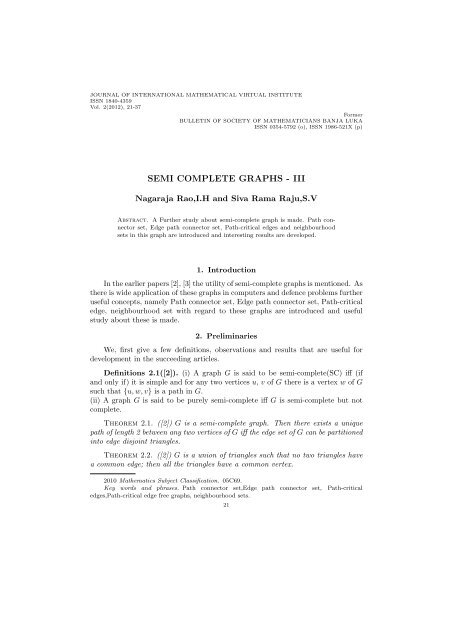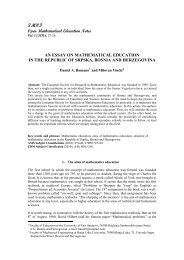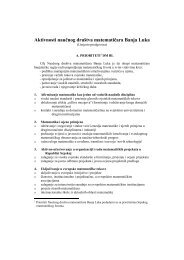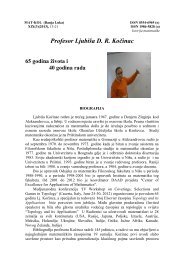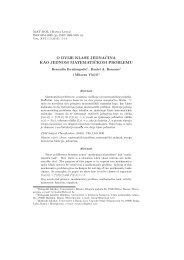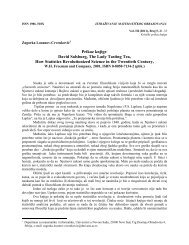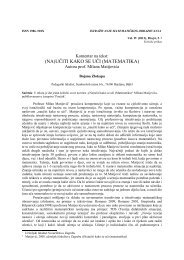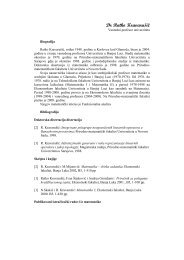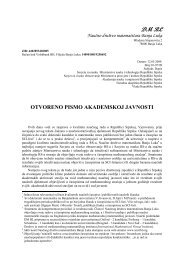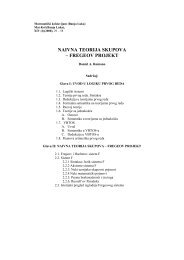semi complete graphs - iii - International Mathematical Virtual Institute
semi complete graphs - iii - International Mathematical Virtual Institute
semi complete graphs - iii - International Mathematical Virtual Institute
Create successful ePaper yourself
Turn your PDF publications into a flip-book with our unique Google optimized e-Paper software.
JOURNAL OF INTERNATIONAL MATHEMATICAL VIRTUAL INSTITUTEISSN 1840-4359Vol. 2(2012), 21-37FormerBULLETIN OF SOCIETY OF MATHEMATICIANS BANJA LUKAISSN 0354-5792 (o), ISSN 1986-521X (p)SEMI COMPLETE GRAPHS - IIINagaraja Rao,I.H and Siva Rama Raju,S.VAbstract. A Further study about <strong>semi</strong>-<strong>complete</strong> graph is made. Path connectorset, Edge path connector set, Path-critical edges and neighbourhoodsets in this graph are introduced and interesting results are developed.1. IntroductionIn the earlier papers [2], [3] the utility of <strong>semi</strong>-<strong>complete</strong> <strong>graphs</strong> is mentioned. Asthere is wide application of these <strong>graphs</strong> in computers and defence problems furtheruseful concepts, namely Path connector set, Edge path connector set, Path-criticaledge, neighbourhood set with regard to these <strong>graphs</strong> are introduced and usefulstudy about these is made.2. PreliminariesWe, first give a few definitions, observations and results that are useful fordevelopment in the succeeding articles.Definitions 2.1([2]). (i) A graph G is said to be <strong>semi</strong>-<strong>complete</strong>(SC) iff (ifand only if) it is simple and for any two vertices u, v of G there is a vertex w of Gsuch that {u, w, v} is a path in G.(ii) A graph G is said to be purely <strong>semi</strong>-<strong>complete</strong> iff G is <strong>semi</strong>-<strong>complete</strong> but not<strong>complete</strong>.Theorem 2.1. ([2]) G is a <strong>semi</strong>-<strong>complete</strong> graph. Then there exists a uniquepath of length 2 between any two vertices of G iff the edge set of G can be partitionedinto edge disjoint triangles.Theorem 2.2. ([2]) G is a union of triangles such that no two triangles havea common edge; then all the triangles have a common vertex.2010 Mathematics Subject Classification. 05C69.Key words and phrases. Path connector set,Edge path connector set, Path-criticaledges,Path-critical edge free <strong>graphs</strong>, neighbourhood sets.21
22 I.H.N.RAO AND S.V.S.R.RAJUDefinition 2.2 ([3]). A <strong>semi</strong>-<strong>complete</strong>(SC) graph G is said to be strong <strong>semi</strong><strong>complete</strong>(S.S.C)iff there is atleast one edge of G whose removal from G does notaffect the <strong>semi</strong>-<strong>complete</strong> property(i.e it results in a <strong>semi</strong>-<strong>complete</strong> graph).A characterization result for a <strong>semi</strong>-<strong>complete</strong> graph to be strong <strong>semi</strong>-<strong>complete</strong>graph is the following:Theorem 2.3. ([3]) A <strong>semi</strong>-<strong>complete</strong> graph G is strong <strong>semi</strong>-<strong>complete</strong> iff thereis an edge uv of G such that there are atleast two paths of length 2 from u to anypoint of N(v) − {u} and v to any point of N(u) − {v}.E.Sampath Kumar [4] introduced the concept of neighbourhood sets as follows:Definition ([4]). (i) A set S of vertices in a graph G is said to be a neighbourhoodset of G iff G = ∪ v∈S< N[v] >, where < N[v] > is the subgraph of Ginduced by ”v” and all its neighbours(adjacent vertices) in G.For convenience, a neighbourhood set of G is referred as n-set of G.Since the vertex set of G is itself an n-set of G, there is no interest to discussabout maximum n-set in a graph.(ii)The minimum among the cardinalities of all n-sets in a graph G is called theneighbourhood number of G and is denoted by n(G).A characterization result for a subset of the vertex set of a graph to be ann − set is the following:Result 2.1. ([4]) A subset S of the vertex set V is an n-set of G iff each edgein < V − S > (the subgraph induced by V-S in G) is in < N[v] > for some v ∈ S.To avoid trivialities, we consider only nonempty <strong>graphs</strong>. Now we introducepath connector set in a graph.3. PATH CONNECTOR SETDefinitions 3.1. (i) A Path connector set(pc-set) in a graph G is a subset V ′of the vertex set V of G such that for any distinct pair of non-adjacent vertices inG there is a shortest path whose internal vertices are from V ′ .(ii) A path connector set in G is said to be a minimum path connector set(mpcset)in G iff(if and only if) it has the minimum cardinality among all the pc-sets inG.Example 3.1. For the graph given in Figure 1 {v 3 , v 5 , v 6 }, {v 3 , v 5 , v 8 } are mpcsets.Observations 3.1. (i) As there are no non-adjacent vertices in the <strong>complete</strong>graph K n , it follows that any subset of the vertex set of K n is a pc-set. In particular,the empty set is also a pc-set(infact mpc-set). So there is no interest in <strong>complete</strong><strong>graphs</strong> with regard to this aspect.(ii) As there are atleast two non-adjacent vertices in a disconnected graph such thatthere is no path between them it follows that pc-sets do not exist for such <strong>graphs</strong>.Clearly
SEMI COMPLETE GRAPHS - III 23v7v8v6v 1v5v4v2v3Figure 1Result 3.1. A non empty graph is connected iff it admits pc-sets.Proof: For, if G is such a graph its vertex set itself is a pc-set(so there is no interestto discuss about maximum pc-sets).Conversely, if G admits pc-sets,then by definition, it follows that G is connected.Note 3.1. Any nonempty connected graph admits mpc-set.For, if V is the vertex set of G then ℘, the class of all pc-sets in G is nonempty,since V ∈ ℘.Hence ℘ admits an element S with minimum cardinality⇒ S is ampc-set in G.Theorem 3.1. (Characterization Result) G is a purely <strong>semi</strong>-<strong>complete</strong> graphwith vertex set V . Then S ⊆ V is a pc-set in G iff for every distinct pair of nonadjacentvertices u and v in G there is a w ∈ S which is adjacent to both u and vin G.Proof. Since G is <strong>semi</strong>-<strong>complete</strong> there is a path of length two between anytwo vertices in G. Then the shortest path between any two non-adjacent verticesis of length two in such a graph. If S is a pc-set in G, by definition, follows thenecessary part.Conversely, if S has the property stated then clearly S is a pc-set inG. □Theorem 3.2. G is a purely <strong>semi</strong>-<strong>complete</strong> graph with vertex set V . Then(a)Any pc-set in G is a dominating set in G.(b)Further, if | S | 2 then S is a total dominating set in G.
24 I.H.N.RAO AND S.V.S.R.RAJUProof. Since any <strong>semi</strong>-<strong>complete</strong> graph is connected, it follows that the graphG admits a nonempty pc-set, say S. If S is singleton say {v 0 } ,then since G is <strong>semi</strong><strong>complete</strong>follows that every vertex of G is adjacent with v 0 . Thus S is a dominatingset in G.Now, assume that | S | 2. Let u ∈ V and v ∈ S − {u}. If u is adjacent tov then we are through; otherwise since G is <strong>semi</strong>-<strong>complete</strong>, there is a w ∈ S suchthat {u, w, v} is a shortest path in G. Now u is adjacent to w ∈ S⇒ S is a total dominating set in G.This <strong>complete</strong>s the proof of the theorem.□Observations 3.2. (i) If S of the above theorem has exactly two elements(vertices)then they are adjacent in G.(ii)S of the above theorem is an independent set iff |S| = 1.Remark 3.1. The converse of Theorem.(3.2(a)) is true iff the cardinality ofthe dominating set is 1.For, that single vertex set is clearly a pc-set (infact a mpc-set ) in G.If the cardinality of the dominating set is > 1 then it need not be a pc-set inview of the following:Example 3.2. Consider the following graph G, in Figure 2v1v 2v6v 3 v4 v5Figure 2clearly {v 2 , v 6 } is a (total) dominating set in G; but this is not a pc-set in G,since there is only one shortest path between v 3 and v 5 ,namely {v 3 , v 4 , v 5 } and v 4is not in {v 2 , v 6 }.Infact, {v 2 , v 4 , v 6 } is a pc-set (further mpc-set) in G.Theorem 3.3. G is purely <strong>semi</strong>-<strong>complete</strong> graph with n vertices.domination number γ(G) = 1 ⇔ |mpcs(G)| = 1.Then the
SEMI COMPLETE GRAPHS - III 25Proof. Since G is purely <strong>semi</strong>-<strong>complete</strong>, it follows that n 4. Let γ(G) = 1.So there is a v 0 ∈ V (G) such that d G (v 0 ) = n − 1. Denote S = {v 0 }. Let v 1 , v 2 ∈V (G) such that v 1 and v 2 are not adjacent in G. Now follows that {v 1 , v 0 , v 2 } is ashortest v 1 − v 2 path in G ⇒ S is a pc-set in G. Since |S| = 1, it follows that S isa mpc-set in G ⇒ |mpcs(G)| = 1Conversely, assume that |mpcs(G)| = 1. So there is a pc-set S in G with|S| = 1. Now, by Theorem.(3.2(a)), it follows that S is a dominating set in G⇒ γ(G) = 1.This <strong>complete</strong>s the proof of the theorem.□Observations 3.3. (i) From Theorem.(3.3) and observation (3.2.(ii)), it followsthat for any such graph G,γ(G) = 1 ⇔ any mpc-set in G is an independentset in G.(ii) From Theorem.(3.2), Remark (3.1) and Theorem.(3.3),we haveA purely <strong>semi</strong>-<strong>complete</strong> graph is a union of triangles, where all the triangleshave a common vertex iff |mpcs(G)| = 1 ⇔ any mpc-set in G is an independent setin G.(<strong>iii</strong>) If G is a <strong>semi</strong>-<strong>complete</strong> graph such that there is a unique path of length twobetween every pair of non-adjacent vertices in G, then |mpcs(G)| = 1 ⇒ there is aunique mpc-set and it is independent set in G.For, by Theorem.(2.2), it follows that,the edge set of G is a union of edgedisjoint triangles where all the triangles have a common vertex⇒ γ(G) = 1⇔ |mpcs(G)| = 1.The converse of (<strong>iii</strong>) is false in view of the following:Example 3.3. Consider the following graph G in Figure 3v1v5v 2 v0v3 v4Figure 3{v 0 } is a mpc-set of G. But there are two paths namely {v 2 , v 0 , v 5 }, {v 2 , v 1 , v 5 }between the pair v 2 , v 5 of non-adjacent vertices in G.
26 I.H.N.RAO AND S.V.S.R.RAJUTheorem 3.4. G is a <strong>semi</strong>-<strong>complete</strong> graph such that |mpcs(G)| = 2. Thenγ(G) = 2.Proof. Under the given hypothesis and Theorem.(3.3), it follows that γ(G) 2. By Th.(3.2) follows that there is a dominating set with 2 elements; so γ(G) 2.Hence γ(G) = 2.□The converse of the above theorem is false in view of the following:Example 3.4. For the graph given in Remark (3.1), {v 2 , v 6 } is a minimumdominating set and so γ(G) = 2 ≠ 3 = |mpcs(G)|.Theorem 3.5. G is a <strong>semi</strong>-<strong>complete</strong> graph such that the triangles formed bythe edges in G have a common edge, say uv iff {u} and {v} are mpc-sets in G(⇒independent sets in G).Proof. Under the given hypothesis ,let S = {u}.Let x, y be non-adjacentvertices in G.⇒ {x, y} ̸= {u, v}. So x, y lie on different triangles of G⇒ Since uv is a common edge of the triangles, follows that {x, u, y} and {x, v, y}are shortest x − y paths in G⇒ {u}, {v} are mpc-sets in G.Conversely, assume that the vertices u, v of G are such that {u}, {v} are mpcsetsin G.⇒ γ(G) = 1⇒ any vertex x /∈ {u, v} of G is adjacent with both u and v. Further u and v mustbe adjacent in G ; otherwise we get a contradiction to the hypothesis. Thus all thetriangles have a common edge uv.This <strong>complete</strong>s the proof of the theorem.□Theorem 3.6. G be a <strong>semi</strong>-<strong>complete</strong> graph which has a cut-vertex,say v 0 . Then{v 0 } is a mpc-set in G(⇒ |mpcs(G)| = 1 ).Proof. By hypothesis follows that v 0 is adjacent to all the other vertices in G⇒ {v 0 } is a pc-set in G⇒ it is an mpc-set in G(|mpcs(G)| = 1).□The converse of Theorem.(3.6) is false in view of the following example:Example 3.5. Consider the following graph G in Figure 4{v 0 } is a mpc-set in G with |{v 0 }| = 1; but v 0 is not a cut-vertex of G.Now, we switch on to Edge path connector sets.4. EDGE PATH CONNECTOR SETDefinitions 4.1. (i) Let G = (V, E) be a graph. Then E ′ ⊆ E is said to be anedge path connector set(Ed.pc-set) for G iff for every pair of non-adjacent verticesu, v in G there is a shortest u − v path whose edges are from E ′ .(ii) A Ed.pc-set with minimum cardinality is said to be a mEd.pc-set for G.
SEMI COMPLETE GRAPHS - III 27v1v4v0v 2v3Figure 4Observation 4.1. G admits an Ed.pc-set ⇒ G is non empty connected. Inthat case E is itself an Ed.pc-set. So we are interested in minimum Ed.pc-sets only.Example 4.1. For the graph given in Figure 5G:v 5v 6v 4v2v1v 3Figure 5{v 1 v 2 , v 2 v 3 , v 3 v 4 , v 4 v 5 , v 5 v 6 , v 6 v 1 , v 1 v 3 , v 3 v 5 } is an Ed.pc-set for G. We observethat this is a mEd.pc-set.Result 4.1. Any Ed.pc-set in a (connected) graph is an edge dominating set.Proof. Let G = (V, E) be a nonempty, connected graph and E ′ be an Ed.pc-setfor G. If E ′ = E then the result is trivial.Otherwise, let e ∈ E − E ′ . Take any e ′ ∈ E ′ .If e&e ′ are adjacent in G, then e ′dominates e. Otherwise, let u be an end of e and u ′ be an end of e ′ . Since u&u ′
28 I.H.N.RAO AND S.V.S.R.RAJUare non-adjacent vertices in G, there is a shortest u − u ′ path whose edges are fromE ′ .⇒ there is an edge f ∈ E ′ such that e&f are adjacent(having the common end u)in G. Hence E ′ is an edge dominating set in G.The converse of the above result is false in view of the following:Example 4.2. For the graph given in Example(3.2),E ′ = {v 4 v 6 , v 2 v 6 , v 2 v 4 } isan edge dominating set in G; it is not an Ed.pc-set for G, since there is no shortestv 3 − v 5 path whose edges are from E ′ .Theorem 4.1. (Characterization Result) G is a purely <strong>semi</strong>-<strong>complete</strong> graphwith edge set E. Then E ′⊆ E is an Ed.pc set in G iff for every pair of distinctnon-adjacent vertices u, v in G, there are adjacent edges e, f in E ′such that eincident with u and f incident with v.Proof. Under the given hypothesis, let E ′be an Ed.pcs(G). Let u, v be twonon-adjacent vertices in G. Now follows that any shortest path between u and v isof length 2. So by the definition of E ′follows the necessary part.Conversely if E ′ has the property stated, clearly E ′ is an Ed.pc set in G. □Result 4.2. G is a purely <strong>semi</strong>-<strong>complete</strong> graph and S is a pc-set. Then theset of all edges which are incident with the vertices of S is an Ed.pc-set for G.Proof: Under the given hypothesis, let E ′ = {e ∈ E : e is incident with an element of S}.Let v 1 , v 2 be two non-adjacent vertices in G. Since G is <strong>semi</strong>-<strong>complete</strong> and S is apc-set for G follows that there is v 3 ∈ S such that {v 1 , v 3 , v 2 } is a path in G.⇒ v 1 v 3 , v 3 v 2 ∈ E ′⇒ A shortest path from v 1 to v 2 has edges from E ′⇒ E ′ is an Ed.pc-set in G.Observation 4.2. The converse of the above result is false in view of thefollowing:Example 4.3. Consider the graph G in Figure 6:S = {v 5 } is a pc set for G and E ′= {v 1 v 2 , v 2 v 3 , v 3 v 4 , v 4 v 5 , v 5 v 1 } is an Ed.pc-setfor G. But, except the edges v 4 v 5 and v 5 v 1 no other edges of E ′is incident withv 5 .Result 4.3. G is a purely <strong>semi</strong>-<strong>complete</strong> graph. If |mpcs(G)| ̸= 1 then anyEd.pc-set for G is an edge cover for G.Proof: Let E ′ be an Ed.pc-set for G. Since |mpcs(G)| ̸= 1 follows that γ(G) ≠ 1.Hence for every u ∈ V (G) there is a v ∈ V such that u is not adjacent to v in G.Since G is <strong>semi</strong>-<strong>complete</strong> any shortest u − v path in G has length 2. Since E ′ is anEd.pc-set for G there is a w ∈ V such that uw, vw ∈ E ′⇒ every vertex of G lies on a an edge of E ′ .⇒ E ′ is an edge cover for G.The converse is false in view of the following:Example 4.4. Consider the graph G in Figure 7:
SEMI COMPLETE GRAPHS - III 29v 4G :v5v 3v 1v2Figure 6v5v4G:v6v3v1v2Figure 7{v 1 v 2 , v 3 v 4 , v 5 v 6 } is an edge cover for G; but it is not an Ed.pc-set for G, sincethere is no shortest v 1 − v 3 path. Further |mpcs(G)| ̸= 1.Result 4.4. G = (V, E) is a purely <strong>semi</strong>-<strong>complete</strong> graph having a unique pathof length 2 between any pair of non-adjacent vertices. Then G has(i) Unique mpc set with single element,say v 0 .(ii)Unique mEd.pc set E ′ given by {v 0 v : v ∈ V − {v 0 }}.Proof: By hypothesis, in virtue of Theorems (2.2) and (2.3), it follows that E is aunion of edge disjoint triangles having a common vertex say v 0 . Now follows thatv 0 is the only vertex which is adjacent with all other vertices of G. Hence followsthat {v 0 } is the only mpc set in G. This proves (i).Consider E ′ = {v 0 v : v ∈ V − {v 0 }}.Let v 1 and v 2 be any two non-adjacent vertices in G, then clearly v 1 ≠ v 0 ≠ v 2 and
30 I.H.N.RAO AND S.V.S.R.RAJU{v 1 , v 0 , v 2 } is a(the) shortest v 1 − v 2 path, where v 0 v 1 , v 0 v 2 ∈ E ′ . Hence E ′ is anEd.pc set of G.If ′ n ′ is the number of edge disjoint triangles in G, then follows that |E ′ | = 2n.If E ′′⊆ E with |E ′′ | < 2n then there is atleast one v ∈ V − {v 0 } such thatv 0 v /∈ E ′′ . Since G has atleast four vertices there is a vertex v ′ which is nonadjacentwith v. Now there is no path of length 2 between v and v ′with edgesfrom E ′′ ⇒ E ′′ is not an Ed.pc set for G. Hence E ′ is a mEd.pc set for G. ClearlyE ′is unique. This proves (ii).Thus the proof of the theorem is <strong>complete</strong>.Note 4.1. If the edge set of G is a union of ′ n ′ edge disjoint triangles then,we observe that |mEd.pcs(G)| = 2n. The converse of this is false in view of:Example 4.5. Consider the following graph in Figure 8:v5v4G:v0v3v6v1v2Figure 8|mEd.pcs(G)| = |{v 0 v 1 , v 0 v 2 , v 0 v 3 , v 0 v 4 , v 0 v 5 , v 0 v 6 }| = 6 = 2(3) = 2(Number ofedge disjoint triangles).But the edge set of G is not a union of ’3’ edge disjoint triangles.Result 4.5. G is a purely <strong>semi</strong>-<strong>complete</strong> graph which is a union of ′ n ′ triangleshaving a common edge. Then |mEd.pcs(G)| = n.Proof: Under the given hypothesis follows that there are (n + 2) vertices in G.Let uv be the common edge of all the ′ n ′ triangles. Now follows that {u} and{v} are mpc-sets for G.Now by Result(4.7),{uw : w ∈ V (G)} is an Ed.pc-set forG.Since u&v are adjacent with all the remaining (n + 1) vertices it follows thatE ′ = {uw : w ∈ V (G)} − {uv} is an Ed.pc-set for G with |E ′ | = (deg G (u)) − 1 = nSimilarly E ′′ = {vw : w ∈ V (G)} − {uv} is an Ed.pc-set for G with E ′′ = n.Let E 0 ⊆ E with |E 0 | < n⇒ there is a w ∈ V (G) − {u, v} such that uw and vw are not in E 0 . Let w ′ be anynon-adjacent vertex with w. Now there is no shortest w − w ′ path with edges fromE 0⇒ |mEP CS(G)| = |E ′ | = |E ′′ | = n.
SEMI COMPLETE GRAPHS - III 31Result 4.6. G is a purely <strong>semi</strong>-<strong>complete</strong> graph with edge set E and S is apc-set for G. Let F = {e ∈ E : e is incident with S}; then H = G(F ) is connected.Proof: Under the given hypothesis G[S] ⊆ H. Let v 1 , v 2 ∈ V (H).Now either none of v 1 , v 2 are in S or atleast one of v 1 , v 2 is in S.Case:1 v 1 , v 2 /∈ S.Now there exists v 3 , v 4 ∈ S such that v 1 v 3 , v 2 v 4 ∈ F . Since v 3 , v 4 ∈ S and G[S] isconnected, there is a v 3 − v 4 path in G[S]⇒ v 1 , v 2 are connected in F .Case:2 Only one of v 1 , v 2 /∈ S.w.l.g we can suppose that v 2 /∈ S ⇒ v 1 ∈ S . Now there is a v 3 ∈ S such thatv 2 v 3 ∈ F . Since there is a v 1 − v 3 path in S follows that v 1 , v 2 are connected in F .Thus F is a connected graph.Result 4.7. G is a purely <strong>semi</strong>-<strong>complete</strong> graph with (n+1) vertices and havinga unique mpc-set and |mpcs(G)| = 1. If |mEd.pcs(G)| < n, then G is strong <strong>semi</strong><strong>complete</strong>. Proof: Under the given hypothesis there exists a subgraph G ′ of Gsuch that the edge set of G ′ is a union of disjoint triangles having common vertex⇒ |mEd.pcs(G ′ )| = n.Since |mEd.pcs(G)| < n ⇒ ∃ vertices v 1 , v 2 on different triangles that are adjacentin G.⇒ ∃ an edge between two vertices lying on different triangles having a commonvertex. Hence by a Theorem.(2.3) G is strong <strong>semi</strong>-<strong>complete</strong>.Now,we consider path- critical edges.5. ON PATH-CRITICAL EDGESDefinitions 5.1. (i) An edge e in a nonempty,connected graph is said to be apath-critical edge w.r.t a mpc-set S in G iff |mpcs(G − e)| > |mpcs(G)|.(ii) G is said to be path-critical edge free w.r.t. S iff no edge of G is a path-criticaledge w.r.t. S.Example 5.1. (i) In the following graph in Figure 9S = {v 2 } is the only mpc-set in G. The edge v 2 v 5 is a path-critical edge(w.r.t.S) in G, since {v 2 , v 5 }, {v 2 , v 4 } are mpc-sets in G − v 2 v 5 .So |mpcs(G − v 2 v 5 )| = 2 > 1 = |mpcs(G)|.(ii) In the graph given in Remark(3.1), S = {v 2 , v 4 , v 6 } is the only mpc-set in G.For any edge e of G,mpcs(G − e) = {v 2 , v 4 , v 6 } = mpcs(G).So G has no path-critical edges (w.r.t S). Thus G is a path-critical edge free w.r.tS.Theorem 5.1. (Characterization Result) G is a purely <strong>semi</strong>-<strong>complete</strong> graphand S is a mpc-set of G. Then the edge e = uv of G is a path-critical edge in Gw.r.t S iff u and v do not a common neighbour from S(⇒ N(u) ∩ N(v) ∩ S = Φ ).Proof. Under the given hypothesis, let e = uv be a path-critical edge in Gw.r.t S. Suppose u and v have a common neighbour from S. Let x,y be any twonon-adjacent vertices in G − e.If {x, y} = {u, v}, then by our supposition there is aw in S such that {w, x, y} is a (minimum) path in (G − e).
32 I.H.N.RAO AND S.V.S.R.RAJUv 1v2v5G:v3v4Figure 9v1G - v2v5 :v2v5v3v4Figure 10If {x, y} ̸= {u, v} then x and y are non-adjacent vertices in G as well . SinceG is <strong>semi</strong>-<strong>complete</strong>, by the definition of S there is a w 0 in S such that {x, w 0 , y} isa minimum path in G − e. Hence follows that S is also a mpc-set in G − e.⇒ e is not a path-critical edge w.r.t. S in G and hence our supposition is false.Conversely, assume that e = uv is such that u and v do not have a commonneighbour from S. LetV 1 = {w ∈ V (G) : {u, w, v}is a path in G}.Since G is <strong>semi</strong>-<strong>complete</strong> it follows that V 1 ≠ Φ.By hypothesis S ∩ V 1 = Φ ⇒ S is not a path connector set for G − e. FurtherS ′ = S ∪ {w 0 }, where w 0 ∈ V 1 is a pc-set in G − e. By the property of S, it followsthat S ′ is a mpc-set for G − e.Hence|mpcs(G − e)| = |mpcs(G)| + 1 > |mpcs(G)|
SEMI COMPLETE GRAPHS - III 33⇒ e is a path-critical edge w.r.t S in G.This <strong>complete</strong>s the proof of the theorem.□Corollary 5.1. G is a purely <strong>semi</strong>-<strong>complete</strong> graph and S is a mpc-set for G.Then G is path-critical edge free graph w.r.t S iff the ends of each edge of G hasatleast one neighbour from S.Theorem 5.2. G is a purely <strong>semi</strong>-<strong>complete</strong> graph whose edge set is a union oftriangles having a common edge. Then there is exactly one path-critical edge w.r.tany mpc-set in G.Proof. Under the given hypothesis, let e = uv be the common edge of thetriangles. Now follows that {u} and {v} are the only mpc-sets in G. Clearly e is apath-critical edge w.r.t these mpc-sets. Further for any other edge ′ f ′ of G, u andv are the only mpc-sets in G − f also. So no other edge is path-critical w.r.t {u}and {v}.This <strong>complete</strong>s the proof of the theorem.□Theorem 5.3. G is a purely <strong>semi</strong>-<strong>complete</strong> graph with ′ n ′ vertices and |mpcs(G)| =1. Then G has exactly (n − 1) path-critical edges w.r.t any mpc-set S of G.Proof. By hypothesis we can assume that, S = {v 0 }(v 0 ∈ V (G)) is a mpc-setfor G. Then for any v 1 ∈ V − S, we have v 1 v 0 ∈ E(G).⇒ |mpcs(G−v 0 v 1 )| = 2 > 1 = |mpcs(G)|⇒ v 0 v 1 is a critical edge for G,w.r.t S.Let u, v ∈ E(G) ∋ u ≠ v 0 ≠ v. Since G is <strong>semi</strong>-<strong>complete</strong> follows that G − uv isconnected and so {u, v 0 , v} is a minimum path in it ⇒ uv is not a path-critical edgew.r.t. S ⇒ G has exactly (n − 1) critical edges.□Corollary 5.2. G be a purely <strong>semi</strong>-<strong>complete</strong> graph which is path-critical edgefree w.r.t a mpc-set S of G. Then |mpcs(G)| > 1.Proof. Under the given hypothesis, if |mpcs(G)| = 1; then by Theorem.(5.3)it follows that G has critical edges w.r.t the mpc-set, say S. This contradicts thehypothesis on S. Hence the result holds.□Observation 5.1. The converse of the above corollary is false in view of thefollowing example in Figure 11:S = {v 1 , v 3 } is a mpcs(G), but G is not critical edge free graph w.r.t S.Finally, we end up by considering the neighbourhood sets.6. ON NEIGHBOURHOOD SETSUsing the Result(2.1) and Corollary(5.1)we have the following characterizationresult for a pc-set in a purely <strong>semi</strong>-<strong>complete</strong> graph to be an n-set for G.Theorem 6.1. S is a pc-set in a purely <strong>semi</strong>-<strong>complete</strong> graph G whose vertex setis V. S is an n-set of G iff every edge in (the subgraph) < V − S > is a non-criticaledge in G w.r.t S.
SEMI COMPLETE GRAPHS - III 35Example 6.2. Consider the graph G given in Example(4.1):S = {v 1 , v 3 , v 5 } is an n-set for G. But this is not an independent set(Infact, anytwo of them are adjacent in G).Theorem 6.3. G is a purely <strong>semi</strong>-<strong>complete</strong> G with vertex set V and S ⊆ V .If each triangle in G has atleast one vertex from S then S is an n-set of G.Proof. Under the given hypothesis, consider any edge e = pq of G. Since G is<strong>semi</strong>-<strong>complete</strong> there is an r ∈ V such that {p, q, r} is a path in G. Now {p, q, r, p}is a triangle in G. By hypothesis either p or q or r is in S ⇒ e ∈< N[v] >, wherev ∈ S. Since e is arbitrary follows that G = ∪ v∈S< N[v] >.Thus S is an n-set of G.□Observation 6.2. The converse of Theorem.(6.2) is false in view of the following:Example 6.3. For the graph in Example(3.2),S = {v 1 , v 3 , v 5 } is an n-set forG. But the triangle {v 2 , v 4 , v 6 } has no vertex from S.From Theorem.(6.2),we have the following:Corollary 6.1. G be a purely <strong>semi</strong>-<strong>complete</strong> graph, then n(G) s, where sis the number of vertex disjoint triangles in G.Theorem 6.4. G is a purely <strong>semi</strong>-<strong>complete</strong> graph in which there is a uniquepath of length 2, between any pair of non-adjacent vertices in G. Then any pc-setis an n-set for G.Proof. Under the given hypothesis,by Theorem.(2.1) and Theorem.(2.2) Gis a union of edge disjoint triangles where all the triangles of G have a commonvertex(say v 0 ). Then any non-trivial pc-set of G, contains v 0 . By the property ofv 0 , in virtue of Theorem.(6.3) follows that any pc-set is an n-set for G. □Finally we prove the following:Theorem 6.5. G is a purely <strong>semi</strong>-<strong>complete</strong> graph with vertex set V and S ⊆V is an independent n-set of G. If < S c > is a clique, then S c is a pc-set for G.Proof. Under the given hypothesis, let u, v be any non-adjacent vertices inG. Since G is <strong>semi</strong>-<strong>complete</strong> there is w ∈ V such that {u, w, v} is a path in G.Since S is an n-set follows that atleast one of u, v is in S.Without loss of generality we can suppose that u ∈ S. Since w is adjacentwith u in G and S is an independent set follows that w /∈ S ⇒ w ∈ S c . Since u, vare arbitrary non-adjacent vertices in G follows that S c is a pc-set(Infact minimumpc-set) in G.□Remark 6.2. The converse of the above Theorem is false in view of the following:Example 6.4. Consider the following graph G in Figure 13:Let S = {v 2 , v 3 , v 5 , v 6 }. Now S c = {v 1 , v 4 }.< S c > is a clique and S c is apc-set for G.But S is not an independent n-set of G.
36 I.H.N.RAO AND S.V.S.R.RAJUv6v5G :v1v 4v2v3Figure 137. ConclusionAs <strong>semi</strong>-<strong>complete</strong> <strong>graphs</strong> play a vital role in tackling defence problems, a <strong>complete</strong>study of these <strong>graphs</strong> gives an overall view to apply them in our practicalproblems. Thus a continuous study about these <strong>graphs</strong> is made.References[1] J.A.Bondy & U.S.R Murthy, Graph theory with Applications, The Macmillan Press Ltd,(1976).[2] I.H.Naga Raja Rao,S.V.Siva Rama Raju Semi-Complete Graphs, IJCC. vol.7(3) (2009), 50 -54.[3] I.H.Naga Raja Rao,S.V.Siva Rama Raju Semi-Complete Graphs - II, IJCC. vol.8(3) (2010),61 - 66.[4] E.Sampathkumar,P.S. Neeralagi, On Neighbourhood Sets, Indian J.Pure Appl.Math.. 16(2):126 (1985).[5] Douglas B. West, Introduction to Graph theory, Pearson Education,Singapore (2002).Received by editors 07.03.2012; avaliable on internet 01.10.2012
SEMI COMPLETE GRAPHS - III 37Sr.Professor & Director, G.V.P.College for P.G.Courses, Rushikonda,Visakhapatnam.,India.E-mail address: ihnrao@yahoo.comDepartment Of Mathematics, M.V.G.R.College of Engineering, Chinthalavalasa,Vizianagaram.,India.E-mail address: shivram2006@yahoo.co.in


